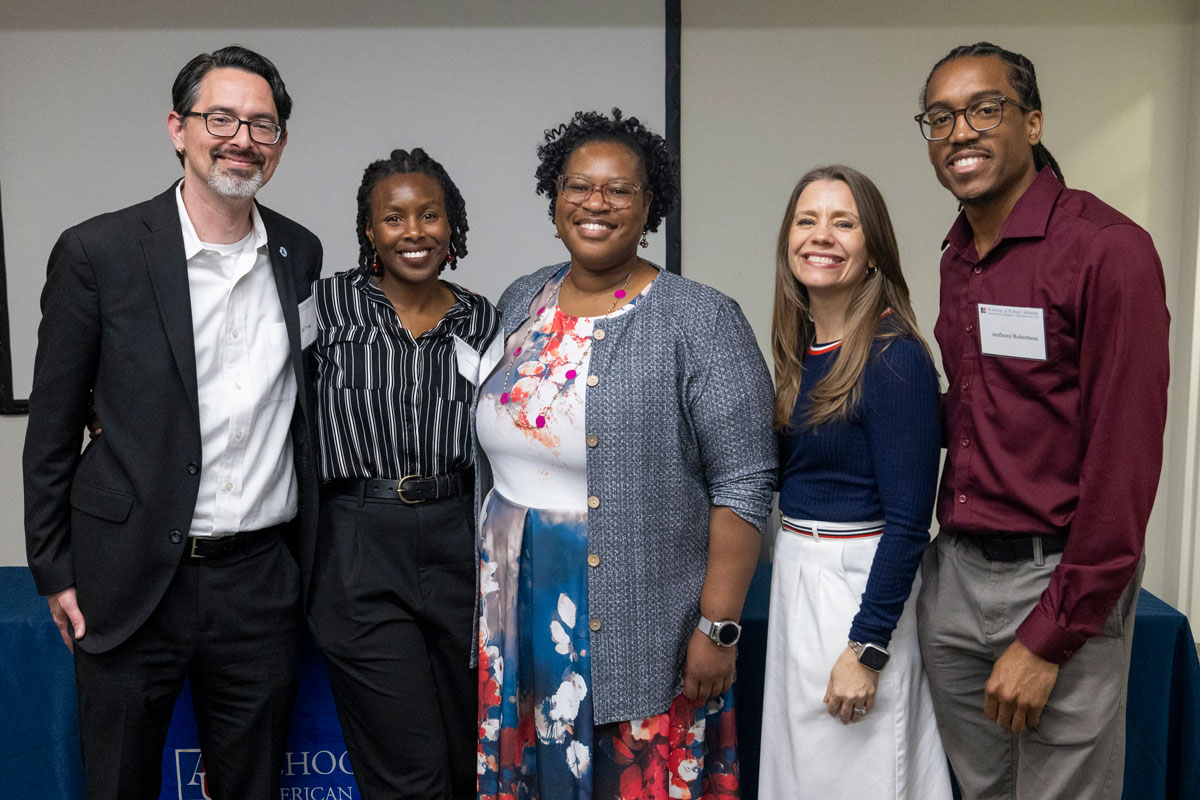Hearing to Heal: NCITE Researchers Host Workshop Exploring Trauma in the Counterterrorism Workforce
Counterterrorism practitioners consume violent media constantly as a part of their work. NCITE researchers Joe Young, Ph.D. and Daisy Muibu, Ph.D. held a workshop with practitioners in April at American University to examine their experiences with vicarious trauma and to source feedback on what can be done to fight it.
- published: 2024/05/21
- contact: NCITE Communications
- email: ncite@unomaha.edu
- search keywords:
- NCITE
- vicarious trauma
- counterterrorism workforce

By Ben Battafarano
NCITE Student Communications Specialist
In January 2002, journalist Daniel Pearl of the Wall Street Journal was abducted en route to an interview in Karachi, Pakistan, by several coordinating Islamist jihadist groups. Nine days later, Pearl was beheaded, and the video of his death released online.
Joe Young, Ph.D., an NCITE researcher and professor in the Department of Justice, Law, and Criminology at American University, watched the video as a part of his work.
“I just kept replaying the images over and over in my head,” said Young.
As his career has progressed, Young has had to process reams of such accounts. The work has had a significant emotional and psychological toll, and in conversation with colleagues experiencing similar problems, he began to wonder at the scope of the issue beyond the research field to the practitioner space.
"In our field more broadly, it’s something that we don’t think a lot about,” said Young. “We don’t think about how, on a larger team, everybody is being affected by being exposed to these violent images and violent stories.”
In 2022, Young and fellow researcher Daisy Muibu, Ph.D., began an NCITE-funded research project examining the effects of vicarious trauma on the counterterrorism workforce. On April 9, the researchers hosted a full-day workshop with 24 counterterrorism practitioners at American University in Washington, D.C., to discuss the impacts of exposure to traumatic material and explore strategies to combat it.
To understand Young and Muibu’s research, it’s important to appreciate the distinction between secondary traumatic stress and vicarious trauma.
We don’t think about how, on a larger team, everybody is being affected by being exposed to these violent images and violent stories.
Secondary traumatic stress is the negative impact from limited, indirect exposure to traumatic material. Watching a single video of real graphic violence, for example, might result in short-term depression, anxiety, or other negative symptoms.
Vicarious trauma is the result of repeated indirect exposure over a long period, manifesting with similar, but ingrained, symptoms that can negatively affect quality of life. Negative effects tend to mount the longer a person is exposed. That said, experts draw a distinction between those experiencing vicarious trauma and those traumatized by direct exposure to violence.
An Under-Researched Population
Researchers have long examined vicarious trauma among social workers and counselors, and to a lesser extent in law, the criminal justice system, health care, and emergency services. But Young said that the counterterrorism field has yet to thoroughly investigate the adverse effects of the phenomenon on its own population.
To fill the gap, the researchers needed to first investigate the prevalence of the problem through extensive interviews and surveys of violence prevention practitioners like intel analysts and federal law enforcement.
Over 70% of their respondents reported regular exposure to violent material. Those reporting higher levels of vicarious trauma also reported less job satisfaction and worse job performance.
The April workshop was designed to foster a dialogue between the research team and end users from the Department of Homeland Security (DHS) and the Office of the Director of National Intelligence, among others. Practitioners and researchers spent the day in and out of small groups discussing effective support strategies and what is needed to strengthen and develop them further.
“It was unbelievable to hear people’s stories,” said Young. “Both in them telling their stories and hearing about ways that these things can be mitigated. People, I think, felt hopeful.”
The Search for Solutions
Nadine Frederique, Ph.D. is the lead of the Social Science Technology Center at the DHS Science and Technology Directorate (S&T) and the technical lead on Young and Muibu’s project. Frederique was impressed by the researchers’ findings in the project’s first year and approved follow-on funding in a cooperative agreement with S&T for its second year.
Frederique has helped move the project forward by researching actionable solutions, such as evaluating the viability of peer support programs to lessen the impact of vicarious trauma.
Frederique said that, while peer support is a popular resilience strategy among professions like first responders, there is little hard evidence of its success.
“We had all these questions,” said Frederique. “What makes a good peer support program? What does the literature say in other domains and fields about the effectiveness of peer support? How would you evaluate one?”
Many of the questions posed to those who attended the workshop were designed so that the research team could learn from practitioners about the support strategies they’ve implemented in their own departments.
“A lot of people develop their own homegrown peer support programs,” said Frederique. “They're not often evaluated, but when they are, and they're published, I think that can give us some insight. I think those are immediately actionable findings that we're going to be able to present to our stakeholders here at DHS to help inform their own programming.”
The researchers will present their findings in June at NCITE’s ENVISION conference, held in Omaha. The project exemplifies one of NCITE’s core research initiatives: bolster the counterterrorism workforce.
“We have to protect the protectors,” said NCITE Director Gina Ligon, Ph.D. “Resilience begins with the counterterrorism practitioner or researcher — and it’s vital that we make sure we are supporting them.”
For Young, the work is deeply personal.
“Both Daisy and I feel very much like this work has meaning and gives us purpose,” he said.